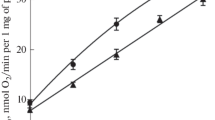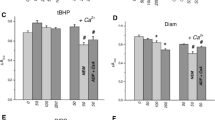Abstract
Addition of Cd2+ or phenylarsine oxide (PhAsO) to respiring rat liver mitochondria results first in acidification of the medium (H+ efflux) followed by disappearance of H+ (discharge of the pH gradient or uncoupling). The first phase of H+ efflux is dependent upon the presence of K+ in the medium, and is not seen in the presence of valinomycin, which is consistent with the conclusion that H+ efflux is linked to membrane potential-dependent uptake of K+. These effects are abolished by low levels of 2,3-dimercaptopropanol but potentiated by excess of 2-mercaptoethanol, showing involvement of a dithiol type of group in the response. Mersalyl produces only the H+ efflux, and subsequent addition of Cd2+ or PhAsO produces collapse of the ΔpH.
Similar content being viewed by others
Abbreviations
- BAL:
-
British Anti-Lewisite or 2,3-dimercaptopropanol
- 2-ME:
-
2-mercaptoethanol
- PhAsO:
-
phenylarsine oxide
- FCCP:
-
carbonylcyanide trifluoromethoxyphenylhydrazone
- HEPES:
-
N-2-hydroxyethylpiperazine-N′-2-ethanesulfonic acid
References
Azzone, G. F., and Massari S. (1973).Biochim. Biophys. Acta 301 195–226.
Brierley, G. P. (1976).Mol. Cell. Biochem. 10 41–62.
Brierley, G. P. (1974).Ann. N.Y. Acad. Sci. 227 398–411.
Diwan, J. J., Markoff, M., and Lehrer, P. H. (1977).Indian J. Biochem. Biophys. 14 342–346.
Fluharty, A. L., and Sanadi, D. R. (1961).Proc. Natl. Acad. Sci. USA 46 608–616.
Fluharty, A. L., and Sanadi, D. R. (1962).Biochemistry 1 276–281.
Fluharty, A. L., and Sanadi, D. R. (1963).Biochemistry 2 519–522.
Garlid, K. D. (1979).Biochem. Biophys. Res. Commun. 87 842–846.
Gaudemer, Y., and Latruffe, P. L. (1974).FEBS Lett. 54 30–34.
Harris, E. J., and Pressman, B. C. (1969).Biochim. Biophys. Acta 172 66–70.
Jacobs, E. E., Jacob, M., Sanadi, D. R., and Bradley, L. B. (1956).J. Biol. Chem. 223 147–156.
Johnson, D., and Lardy, H. (1967).Methods Enzymol. 10 94–95.
Mitchell, P. (1966).Biol. Rev. 41 445–502.
Stiggal, D. L., Galante, Y. M., Kiehl, R., and Hatefi, Y. (1979).Arch. Biochem. Biophys. 196 638–644.
Author information
Authors and Affiliations
Rights and permissions
About this article
Cite this article
Rao Sanadi, D., Hughes, J.B. & Joshi, S. Activation of potassium-dependent H+ efflux from mitochondria by cadmium and phenylarsine oxide. J Bioenerg Biomembr 13, 425–431 (1981). https://doi.org/10.1007/BF00743214
Received:
Issue Date:
DOI: https://doi.org/10.1007/BF00743214




